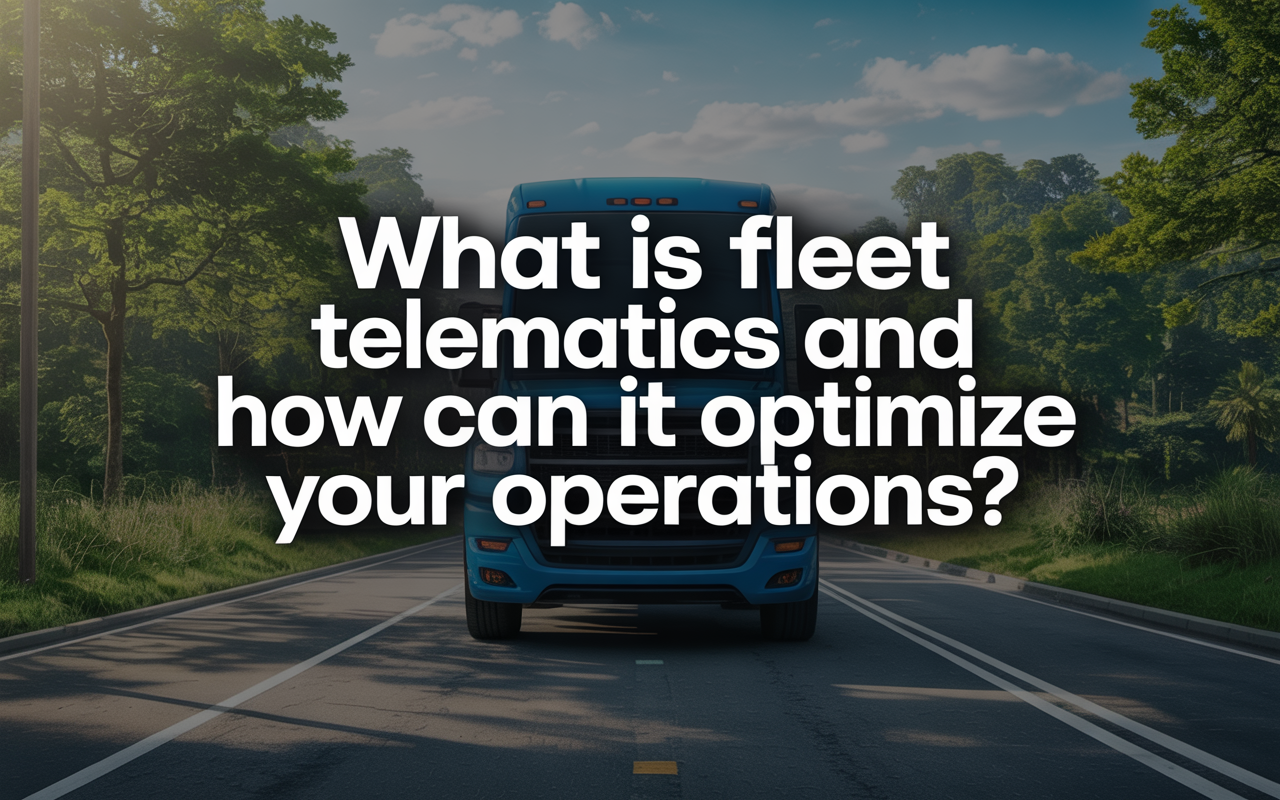What is Fleet Telematics and How Can It Optimize Your Operations?
Introduction to Fleet Telematics
Fleet telematics refers to the technology that combines GPS tracking, vehicle sensors, and cellular communication to monitor and manage fleets of vehicles. This system allows fleet managers to gather real-time data about their vehicles’ location, performance, and driver behavior. With advancements in technology, telematics has become an essential tool for businesses in transportation, logistics, and service industries. 🚛💨
As industries grow more competitive, the need for efficient fleet management becomes critical. Fleet telematics provides a way to streamline operations, reduce costs, and improve safety. By integrating these technologies, companies can stay ahead of the curve and ensure their fleets are operating at peak efficiency. Now, let’s dive into how fleet telematics actually works. 📊🔍
How Does Fleet Telematics Work?
Fleet telematics systems consist of hardware installed in vehicles and software that processes and displays the collected data. The hardware includes GPS devices, sensors, and communication modules that send information to a central management system. This system collects data on vehicle location, speed, fuel consumption, engine diagnostics, and more. 🌍📡
Once the data is collected, fleet operators can access it through user-friendly dashboards. These dashboards provide real-time analytics, helping managers make informed decisions quickly. For example, they can reroute vehicles to avoid traffic or schedule maintenance before a breakdown occurs. With this setup, fleet telematics transforms raw data into actionable insights. 🧠📊
Key Benefits of Fleet Telematics for Modern Operations
One of the biggest advantages of fleet telematics is enhanced visibility and real-time tracking. Managers can see where every vehicle is at any given moment, which improves coordination and customer service. This level of transparency ensures that deliveries are on time and resources are used efficiently. 📍⏰
Another key benefit is data-driven decision-making. Telematics provides detailed reports on vehicle performance and driver behavior, allowing managers to identify inefficiencies and implement improvements. This leads to better resource allocation and cost savings. 💡📈
Lastly, fleet telematics simplifies compliance and regulatory reporting. Automated systems capture necessary data for regulations like hours of service (HOS) and electronic logging devices (ELDs). This reduces paperwork and ensures accuracy during audits. As a result, businesses can focus more on operations and less on administrative tasks. ✅📄
“Fleet telematics systems combine GPS tracking and vehicle diagnostics to provide real-time data on location, driver behavior, fuel usage, and engine health. This data helps fleets reduce costs, improve maintenance, and increase safety.”-Fleetio
Real-Time Vehicle Tracking and Location Management
GPS tracking is a cornerstone of fleet telematics, enabling managers to monitor vehicle locations in real time. This feature is invaluable for responding to customer requests promptly and optimizing routes. For instance, if a delivery needs to be expedited, managers can quickly identify the nearest available vehicle. 🚙📍
Beyond customer satisfaction, real-time tracking also helps with fleet deployment. Managers can ensure vehicles are being used efficiently and avoid unnecessary downtime. Additionally, it aids in route optimization, reducing travel time and fuel consumption. This not only saves money but also minimizes the environmental impact. 🌱💰
“One of the most immediate benefits of fleet telematics is the ability to track vehicles in real time. Using GPS technology, fleet managers can monitor the location, speed, and direction of each vehicle in their fleet. This level of visibility is invaluable for coordinating logistics, responding to customer inquiries, and ensuring that drivers adhere to their routes.”-SimplyFleet
Improving Fuel Efficiency
Telematics plays a crucial role in reducing fuel costs by identifying inefficient driving habits and routes. For example, excessive idling, speeding, and harsh braking can all lead to higher fuel consumption. By addressing these behaviors, fleet managers can significantly cut down on expenses. ⛽📉
Moreover, telematics helps optimize routes, ensuring vehicles take the most efficient paths. This not only reduces fuel usage but also lowers wear and tear on vehicles. Over time, these savings add up, contributing to a healthier bottom line. Companies that prioritize fuel efficiency often see a noticeable improvement in their overall operating expenses. 📉💼
“Running a fleet presents unique challenges, such as meeting FMCSA regulations, controlling fuel costs and exceeding customer demands.Technology advantages help businesses effectively address these issues by improving compliance, reducing costs, and boosting the efficiency of fleet operations.”-Radius
Enhancing Driver Safety and Behavior
Driver safety is another area where telematics shines. By monitoring behaviors like speeding, harsh braking, and rapid acceleration, fleet managers can identify risky drivers and provide coaching. This proactive approach helps reduce accidents and promotes a culture of safety. 🚦🛡️
Besides improving safety, telematics can also lower insurance costs. Insurance providers often offer discounts to fleets that use telematics to monitor and improve driver behavior. This creates a win-win situation, where both safety and financial benefits are realized. Investing in driver safety is not just good ethics-it’s also good business. 💼🚗
“Fleet telematics systems often include features that monitor driver behavior, such as speeding, harsh braking, and rapid acceleration. This information can be used to identify drivers who may need additional training or coaching. By promoting safer driving habits, businesses can reduce the risk of accidents, lower insurance premiums, and minimize wear and tear on vehicles.”-SimplyFleet
Preventive Maintenance and Reduced Downtime
Telematics systems can alert fleet managers when vehicles are due for maintenance based on mileage, engine hours, or diagnostic trouble codes. This proactive approach prevents unexpected breakdowns and extends the lifespan of vehicles. Regular maintenance also ensures vehicles are operating at peak efficiency. 🔧🔧
By avoiding costly repairs and minimizing downtime, businesses can save significant amounts of money. Preventive maintenance reduces the risk of disruptions, keeping operations running smoothly. In industries where time is money, this reliability is invaluable. A well-maintained fleet is a cornerstone of successful fleet management. 🏭💪
“Telematics systems can provide alerts when a vehicle is due for service, based on mileage, engine hours, or diagnostic trouble codes. This proactive approach to maintenance can prevent costly breakdowns and extend the lifespan of vehicles.”-SimplyFleet
Meeting Regulatory Compliance and Simplifying Reporting
Fleet telematics makes it easier to comply with regulations such as electronic logging devices (ELDs) and hours of service (HOS). Automated data capture ensures accuracy and eliminates manual entry errors. This simplifies audits and recordkeeping, saving time and reducing stress. 📑🔒
Furthermore, telematics systems generate reports that meet regulatory standards, making it easy to demonstrate compliance. This is especially important for industries with strict oversight, such as trucking and logistics. By streamlining compliance, fleet managers can focus on what they do best-managing their operations effectively. 🚛📋
“Telematics includes vehicle tracking, asset tracking and vehicle camera systems to help fleet managers save money and operate efficiently.”-Radius
The Role of Video Telematics and AI Cameras
Video telematics takes fleet management to the next level by adding visual context to data. AI-powered cameras detect risky behaviors, such as distracted driving, and provide real-time alerts to drivers. This enhances risk management and helps prevent incidents before they happen. 🎥🤖
In addition to preventing accidents, video telematics is invaluable for incident reconstruction. If an accident does occur, recorded footage can be used to determine what happened and assign responsibility. This not only aids in claims management but also improves overall safety protocols. Adding video to telematics is a game-changer for fleet operations. 🚨📸
“By harnessing the power of telematics, fleets can work smarter, safer, and more affordably. Keep reading for more on the top benefits of fleet telematics and take a big step toward transforming your business.”-GoMotive
Integrating Telematics with Broader Fleet Management Software
When telematics data is integrated with broader fleet management platforms, it creates a comprehensive view of operations. Dispatch, inventory, and customer engagement can all be managed from a single system. This integration streamlines workflows and improves decision-making. 🔄💻
For example, dispatchers can use telematics data to assign jobs based on vehicle location and availability. Inventory managers can track shipments in real time, ensuring timely deliveries. By combining telematics with other tools, businesses can achieve total operational oversight and maximize efficiency. 📦🚚
Security and Theft Prevention through Telematics
Telematics enhances security by providing real-time tracking, geofencing, and alert systems. If a vehicle leaves a designated area, managers receive immediate notifications. This not only protects fleet assets but also assists in theft recovery. With telematics, fleet owners can rest assured their vehicles are safe. 🔒🚨
Cost Savings and Return on Investment with Telematics
Telematics delivers direct and indirect cost savings by reducing fuel consumption, maintenance expenses, and insurance premiums. Improved asset utilization also contributes to a healthier bottom line. Businesses that adopt telematics often see a rapid return on investment. 💰📈
For example, optimized routes and reduced idling lead to lower fuel costs. Timely maintenance prevents costly repairs, while safer driving behaviors reduce insurance claims. Over time, these savings add up, making telematics a smart financial decision. Investing in telematics is an investment in the future of your fleet. 🏦🌟
Challenges and Considerations When Implementing Telematics
While telematics offers numerous benefits, there are challenges to consider. Upfront costs, choosing the right provider, and managing data privacy are common concerns. Fleet managers must weigh these factors carefully to ensure a successful implementation. 💭💡
Driver buy-in is another critical factor. Some drivers may feel uncomfortable with being monitored, so clear communication about the benefits is essential. Addressing these challenges head-on will help businesses reap the full rewards of telematics. With careful planning, the transition can be smooth and effective. 🤝🚀
Frequently Asked Questions (FAQ)
-
What types of vehicles or fleets benefit most from telematics? Telematics is ideal for fleets in transportation, logistics, construction, and service industries. Any business with multiple vehicles can benefit from improved tracking, efficiency, and safety. 🚛📦
-
Is telematics difficult to install and manage? Modern telematics systems are designed for ease of use. Many offer plug-and-play installation, while others require professional setup. Daily management is straightforward, thanks to intuitive dashboards. 🛠️📱
-
How does telematics impact driver privacy? Privacy concerns are valid, but reputable providers ensure data security and compliance with regulations. Clear policies and communication can address driver worries. 🔐🗣️
-
Can telematics help with accident reduction and claims management? Yes, telematics promotes safer driving and provides evidence for claims. This reduces accidents and simplifies insurance processes. 🚦📝
-
What is the average return on investment for a fleet adopting telematics? ROI varies but typically ranges from 10% to 30%. Factors like fleet size, industry, and usage patterns affect payback periods. 💹📈
Conclusion
Fleet telematics is a powerful tool for modern fleet optimization, offering benefits in safety, efficiency, compliance, and cost savings. By leveraging real-time data and analytics, businesses can make smarter decisions and stay competitive. The ability to track vehicles, monitor driver behavior, and streamline operations is invaluable in today’s fast-paced world. 🚀🌐
If you’re a fleet owner or manager, now is the time to explore telematics solutions tailored to your needs. Evaluate providers, consider upgrading your technology, and take steps toward a more agile, safe, and profitable operation. Investing in telematics isn’t just about staying current-it’s about securing the future of your business. 🌟💼


